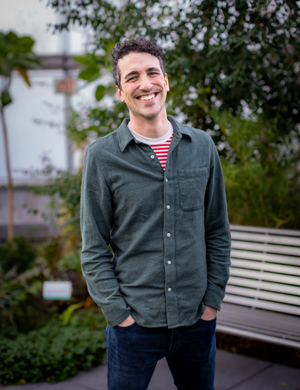
Jared Rubinstein comes to his new position with a wealth of experience working with collections in higher education settings. Plus, he’s no stranger to the University of Minnesota where he earned his master’s degree in Applied Plant Sciences. Now, he’s back on campus in a new role overseeing day-to-day operations and developing the collections at the CBS Conservatory.
You joined the Conservatory earlier this year. What drew you to the role of curator of the CBS Conservatory & Botanical Collection?
I love that the Conservatory lets Minnesotans see how diverse the world of plants truly is. Our flora in the Upper Midwest is a bit limited because of the cold and we tend to see the same plants over and over again, at least outdoors. The Conservatory’s collection has so many weird and unusual plants that can’t grow here and they (I hope) inspire people to realize how exciting and diverse the natural world is.
You’ve held positions at Arnold Arboretum at Harvard University and Scott Arboretum at Swarthmore College. What appeals to you about working with plant collections in a higher education context?
Collections connected to higher education often come with a very clear mission to educate and engage. I love display gardens and spend a lot of time trying to make my own yard pretty, but I think there is something special about a plant collection that is specifically curated to teach visitors about botany, biodiversity, plant conservation, and climate change.
The new facility opened just before the pandemic. As we return to in-person engagement, what are your plans for education and outreach in the new space?
For now we’re really focused on making sure that the collection is being used by the University community–that means working with faculty to revitalize their curricula, inviting departments to tour the space or host events, acquiring new plants specifically for labs or lectures, and even removing some unused or unneeded plants. It also means making sure we’re using all the best practices in our horticultural care to ensure our plants are thriving. Beyond that, I’d love to find a way to make the Conservatory accessible to the public more regularly. There is so much we can offer, we just need to be creative about how to get people into the space.
This is actually a return to the University of Minnesota for you since you completed your graduate studies here. Any fond memories from your time as a student? Anything that’s stuck with you and shaped your path?
One thing I appreciated during graduate school and still appreciate now is that there is always someone doing whatever it is you’re interested in. Whether it’s fruit breeding, plant-fungal associations, oak diversity, the evolution of flowers, you name it, there’s someone working on it who is willing to answer some questions or offer some advice. Asking questions is so important to managing a living collection as diverse as ours of collection, and I love how many people at the University have expertise to offer.
It’s early days and unfair to make you pick, but which of the four biome rooms is your favorite and why?
I’m drawn to our Antarctic Forest — it’s a high-elevation cloud forest and probably the most similar to Seattle, where I grew up. Some of the plants in that biome, like the Gunnera tinctoria, grow in my parent's garden and the cool, wet climate is very familiar and comforting.